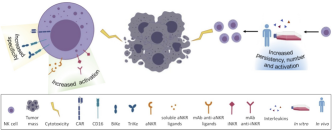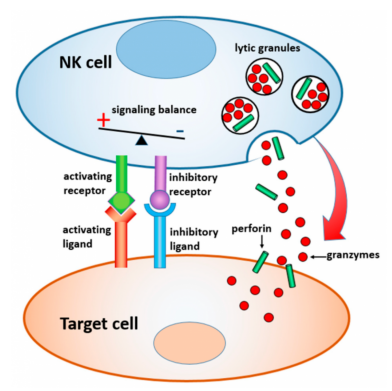Please click the button below to go to our email login page
|
How should the research regarding natural killer cells, broad-spectrum killers of immunity of human body, be carried out?Natural killer (NK) cells represent the third lymphocyte population
following T and B cells, playing an indispensable role in the immunity of human
body. Today, let’s learn the basic knowledge of NK cells and relevant research
ideas. NK cells NK cells arise from lymphoid stem cells in bone marrow, which are widely distributed cytotoxic lymphocytes, and occupy the central position in innate immune system. NK cells constantly circulate throughout the body along with blood system and play a role in immune surveillance. NK cells can kill tumor cells, virus-infected cells and other cells under physiological stress (e.g. senescent cells) without previous sensitization by antigens.
NK cell receptor types (1)Receptors that suppress the killing effect of NK cells are called NK cell surface inhibitory receptors, including Tim-3 and NKG2A. (2) Receptors that provoke the killing effect of NK cells are termed NK cell-activating receptors, covering NKp46, NKG2D and NKP30. The process of NK cells recognizing and killing target cells The normal cell surface displays MHC-I to prevent immune system attack. However, MHC-I level is reduced in the surfaces of virus-/tumor-induced cells, weakening the role of NK cell surface inhibitory receptors. Also, the increase of stress protein and other ligand expressions can impact NK cell-activating receptors, thus enhancing the killing activity of NK cells and bringing about the necrosis and apoptosis of virus-infected and tumor cells. The approach of the activated NK cells killing target cells (1) Release of activity mediators, such as perforin and granzyme. Perforin is responsible for pore formation in membranes of target cells, causing target cell necrosis. Granzyme enters target cells, activates the endogenous endonuclease system and induces DNA breakage to result in cell apoptosis. (2) Death receptor/ligand interaction. NK cells generally express three death ligands, Fas ligand (FasL), tumor necrosis factor (TNF) ligand, and TNF-related apoptosis inducing ligand (TRAIL), that can trigger cell apoptosis upon interaction with specific death receptors on the surface of tumor cells. (3) Antibody-dependent cell-mediated cytotoxicity (ADCC). CD16 in NK cells can bind to IgG Fc in target cells and activate it through signal transduction to selectively attack target cells and play an ADCC role. (4)Secretion of a series of cytokines and chemokines. NK cells secrete several cytokines such as interferon-γ (IFN-γ), tumor necrosis factor-α (TNF-α), and interleukin (IL)-2. Among them, IFN-γ can inhibit tumor cell proliferation, block tumor angiogenesis and elevate MHC expression to stimulate antigen presentation; TNF-α activates endonucleases of target cells, degrades DNA and triggers programmed cell death; and IL-2 promotes NK cell proliferation and potentiates its killing effect.
Common research ideas about NK cells Four steps are identified after we summarized common research ideas about NK cells based on loads of relevant references. (1) Determination of tumor types (2) Retrieval of the researched role and mechanism of NK cells in target tumor microenvironment from references. (3) Exploration of whether certain drugs or treatment methods can enhance the anti-tumor activity of NK cells based on molecular mechanism of interest. (4) Formulation of project experiment scheme from clinical, in vivo and in vitro perspectives based on research purposes and scientific hypothesis. |


